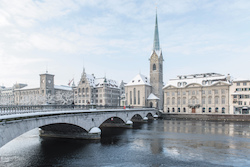Speaker
Frederic Flin
(Meteo-France CNRS / CNRM UMR 3589 / CEN)
Description
Once deposited on the ground, snow forms a complex porous material whose microstructure constantly transforms over time. These evolutions, which strongly impact the physical and mechanical properties of snow (e.g. Srivastava et al, 2010; Calonne et al, 2014; Wautier et al, 2015) need to be considered in details for an accurate snowpack modeling. However, some of the physical mechanisms involved in metamorphism are still poorly understood. To address this problem, several investigations combining X-ray tomography and 3D micro-modeling have been carried out over the past decade (e.g. Flin et al, 2003; Kämpfer and Plapp, 2009; Pinzer et al, 2012) but precise comparisons between experimentation and modeling remain difficult. One of the difficulties comes from the lack of high resolution time-lapse series for experiments occurring with very well-defined boundary conditions, and from which precise measurements of the interfacial growth rates can be done.
Thanks to CellDyM, a recently developed cryogenic cell (Calonne et al, 2015), we conducted in situ time-lapse tomographic experiments on several snow and ice samples under various conditions. We focus here on a 28 h experiment of isothermal metamorphism at -7°C. The non-destructive nature of X-ray microtomography yielded a series of 8 micron resolution images that were acquired with a 2 to 12 h time step. An image analysis method was implemented to estimate the normal growth rates on each point of the ice-air interface and applied to the series obtained. In addition, a curvature-based phase-field model (Bretin et al, 2015) was used on the first image of the experimental series to compute the snow evolution under a pure sublimation-condensation mechanism: the numerical morphologies were then compared to the experimental ones.
The analysis of all the results gives interesting outlooks for the understanding of the physical mechanisms involved in snow isothermal metamorphism. In particular, our measurements tend to confirm the recent observations of Krol and Löwe (2016) that suggest the sublimation-condensation might be predominant over the vapor diffusion mechanism.
References:
--------------
Bretin, E., et al, (2015), Tech. Rep. D4 of the DigitalSnow ANR Project.
Calonne, N., et al (2015), Geophys. Res. Lett., 42.
Calonne, N., et al (2014), The Cryosphere, 8, 2255-2274.
Flin, F., et al (2003), J. Phys. D. Appl. Phys., 36, A49-A54.
Kämpfer, T. U., and M. Plapp (2009), Phys. Rev. E, 79 (3), 031502.
Krol, Q., and H. Löwe (2016), J. Glaciol., 62 (232), 378-390.
Pinzer, B., et al (2012), The Cryosphere, 6, 1141–1155.
Srivastava, P., et al (2010), Annals of Glaciology, 51 (54), 73-82.
Wautier, A., et al (2015), Geophys. Res. Lett., 42, 8031–8041.
Significance statement
This study presents an analysis of an experiment of snow isothermal metamorphism monitored by time-lapse tomography. Measurements of interfacial velocities as well as phase-field modeling are used to investigate the physical mechanisms involved.
Primary author
Frederic Flin
(Meteo-France CNRS / CNRM UMR 3589 / CEN)
Co-authors
Anne Dufour
(Meteo-France CNRS / CNRM UMR 3589 / CEN)
Bernard Lesaffre
(Meteo-France CNRS / CNRM UMR 3589 / CEN)
Christian Geindreau
(Univ. Grenoble Alpes - CNRS - Grenoble INP / 3SR)
Corentin Mehu
(Meteo-France CNRS / CNRM UMR 3589 / CEN)
Elie Bretin
(Univ. Lyon / Institut Camille Jordan)
Jacques Roulle
(Meteo-France CNRS / CNRM UMR 3589 / CEN)
Neige Calonne
(Meteo-France CNRS / CNRM UMR 3589 / CEN)
Pascal Hagenmuller
(Meteo-France CNRS / CNRM UMR 3589 / CEN)
Philippe Lapalus
(Meteo-France CNRS / CNRM UMR 3589 / CEN)
Roland Denis
(Univ. Savoie Mont-Blanc - CNRS / LAMA UMR 5127)
Mr
Rémi Granger
(Univ. Grenoble Alpes, CNRS, Grenoble INP, 3SR, F-38000 Grenoble, France / Météo-France – CNRS, CNRM UMR 3589, CEN, 38400 Saint Martin d'Hères, France)
Sabine Rolland du Roscoat
(Univ. Grenoble Alpes - CNRS - Grenoble INP / 3SR)

